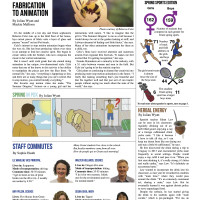
It’s the second half of a Grant girls lacrosse game with just a few minutes remaining on the clock. The ball is on the ground and two players run after it, positioning their bodies to get in front. They get low to the ground, make contact and the Grant player comes up with the ball.
But a referee blows the whistle and the player is given a penalty for a dangerous push. She is placed four meters behind her opponent, and the game continues.
You would never see a call like this made during a boys game. (Not to mention the fact that girls are required to wear skirts and limited protective gear in games, while boys wear shorts with helmets and heavy padding). That’s because the rules of boys lacrosse make room for physicality, while girls lacrosse punishes aggressive play.
These rules implicitly and overtly tell us that we aren’t tough enough to withstand the physical nature of the sport. The message is, because we’re girls, we need to be protected through strict rules and limiting clothing. Wearing skirts brings nothing to the game. This notion, which undermines the strides that women have made to gain a foothold of equity in athletics, needs to be changed.
Lacrosse was first played by Native Americans in the northeastern region of what is now the United States. In the mid-nineteenth century, it was adopted by European cultures and remained a male-dominated sport until 1890. That’s when the first recorded game of women’s lacrosse took place in Scotland. In 1933, the first women’s national tournament was held in Connecticut, and since then it has slowly grown in popularity among female athletes.
Even from the early days of the sport, the versions of lacrosse for male and female athletes have differed significantly. The boys sport has always emphasized aggressiveness and strength, while the girls version displays finesse and control.
Today, the two games have little in common.
Male players wear chest pads, elbow pads, protective gloves, a helmet and mouth guard, along with shorts and a sleeved jersey. But the equipment of the girls’ game is limited to protective eye goggles and a mouth guard, paired with a short skirt and tank top jersey.
And as the equipment varies, so do the rules. In girls’ games, checks to the body or even near the body are strictly prohibited. A legal check is stick-to-stick contact that is quick and controlled, one of a multitude of rules designed for the safety of the players. These restrictions disrupt the flow of the game. Contrast that with the boys game where male athletes are allowed to make stick-to-body contact much more often without a ref’s whistle constantly stopping play.
At Grant, the inherent bias in favor of boys lacrosse was made especially clear a few years ago when the turf field was laid down with only permanent lacrosse lines for boys. The girls’ lines were an afterthought, spray painted on weeks later.
Despite strides made earlier this year in opening all combat jobs in the military to women, there remains a disparity when it comes to athletics.
At the high school level, Title IX – the federal law that requires equal opportunity to participate in sports for men and women – does not require institutions to offer identical sports but equal opportunities to play. Given that, it’s up to high school and college lacrosse organizations to do something about the sexist rules, equipment and uniforms.
When we walk off the field frustrated with having to play a less physical game, it forces us to question why we keep going back. In most other sports – including soccer and basketball – girls and boys games share the same uniforms, field lines and rules.
So why not lacrosse? If we want girls to feel empowered and strong, we have to change the rules and traditions that have been set up to hold them back. The Grant girls lacrosse team is getting new uniforms next spring. We think it’s time that we break with tradition and choose shorts over skirts. ◊




